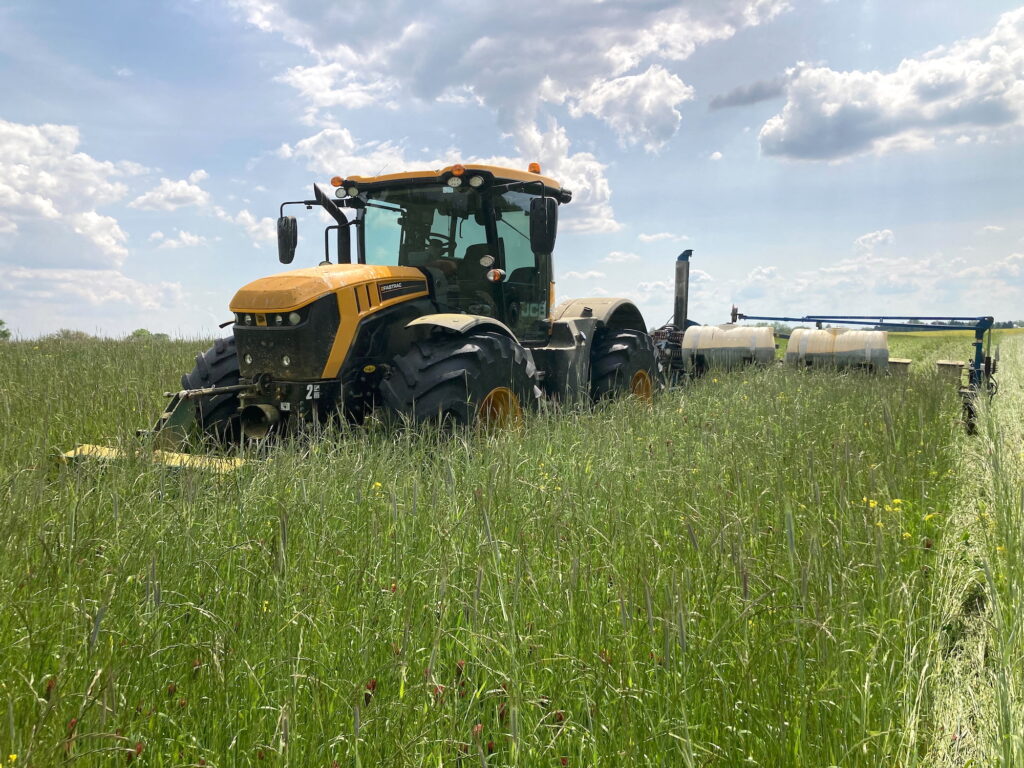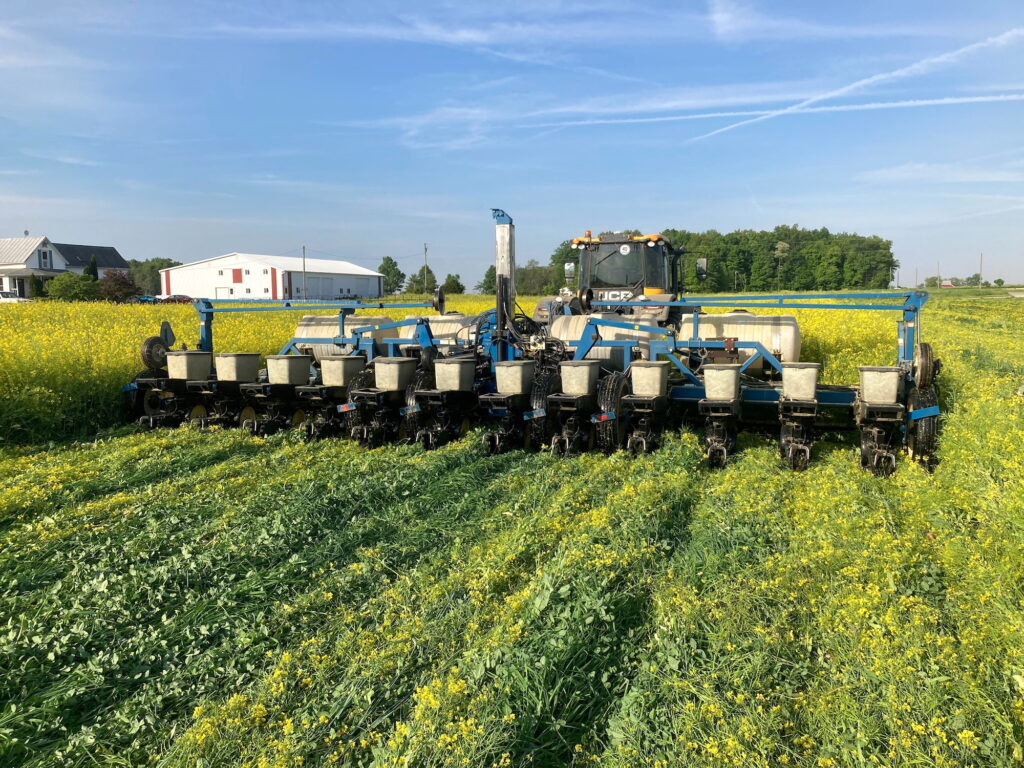By Karl Plume | Photos by Dave Gruenbaum/Handout via Reuters
CHICAGO (Reuters) – Illinois farmer Jack McCormick planted 350 acres of barley and radishes last fall as part of an off-season crop that he does not intend to harvest. Instead, the crops will be killed off with a weed killer next spring before McCormick plants soybeans in the same dirt.
The barley and radishes will not be used for food, but Bayer AG will pay McCormick for planting them as the so-called cover crops will generate carbon offset credits for the seeds and chemicals maker.
The purpose of cover crops is to restore soil, reduce erosion, and to pull climate-warming carbon from the atmosphere through photosynthesis. The carbon trapped in roots and other plant matter left in the soil is measured to create carbon credits that companies can use to offset other pollution.
The practice shows how the agriculture industry is adapting as a result of climate change. Farmers no longer make money merely by selling crops for food and livestock feed—they may also be paid for the role crops can play in limiting planet-warming emissions.
Farmers no longer make money merely by selling crops for food and livestock feed—they may also be paid for the role crops can play in limiting planet-warming emissions.
More and more US farmers are planting cover crops, from grasses like rye and oats to legumes and radishes. While some are converted into biofuels or fed to cattle, most are not harvested because their value is greater if they break down in the soil.
Cover crops are a pillar of regenerative agriculture, and they are generally seen by environmentalists as an improvement over traditional agriculture. It is an approach to farming that aims to restore soil health and curb emissions through crop rotation, livestock grazing, cutting chemical inputs, and other practices.
Rob Myers, director for the Center for Regenerative Agriculture at the University of Missouri, estimates cover crop plantings swelled to as much as 22 million acres in 2021. That is up 43 percent from the 15.4 million acres planted in 2017, according to the most recent US Department of Agriculture (USDA) data.

“There are so many things pushing cover crops forward. The carbon payments are the newest thing. We’ve seen a tremendous farmer interest in soil health,” he said.
Myers estimates that by the end of the decade between 40 million and 50 million acres of cover crops will be planted annually.
The surge will likely accelerate as government and private conservation programs expand, experts say.
An even greater expansion of cover crop acreage in coming years could be a boon to seed and fertilizer companies, though the companies say it is hard to predict which cover crops farmers will decide to plant.
Companies including Bayer, Land O’Lakes, and Cargill Inc have launched carbon farming programs over the past two years that pay growers for capturing carbon by planting cover crops and reducing soil tillage.
“There are so many things pushing cover crops forward. The carbon payments are the newest thing. We’ve seen a tremendous farmer interest in soil health,” said Rob Myers, director for the Center for Regenerative Agriculture at the University of Missouri.
Land O’Lakes subsidiary Truterra paid out $4 million to US farmers enrolled in its carbon program in 2021 for efforts the company says trapped 200,000 metric tons of carbon in soils.
Others are expanding from small pilot programs, including Cargill, which aims to increase its sponsored sustainable farming programs to 10 million acres by the end of the decade, up from around 360,000 acres currently. Seedmaker Corteva Inc boosted its carbon offering from three US states to 11 for the 2022 season.
Federal conservation programs have for years paid farmers to set aside environmentally sensitive lands such as flood plains or wildlife habitat, and the Biden administration plans to expand those programs. President Joe Biden’s Build Back Better legislation targeted some $28 billion for conservation programs, including up to $5 billion in payments to farmers and landowners for planting cover crops, though the bill’s fate remains unclear.
Want to do it
Much of the growth in cover crop plantings to date has been led by a limited number of conservation-conscious farmers pursuing other goals such as soil fertility or water management. Program payments rarely cover the cost of seeds and labor.

“You’ve got to want to do it,” said McCormick, who has increased his cover crop acres more than tenfold over the past six years and received his first payment from Bayer this autumn.
“If somebody wants to hand me a couple of bucks an acre for something I’m doing, I’ll take it. But I wouldn’t do it just for the incentive. I don’t think the incentives are great enough,” he said, adding that his main motivation is the role played by cover crops in improving soil and making his farm more drought tolerant.
Similarly, Ohio farmer Dave Gruenbaum rapidly increased his cover crop plantings beginning five years ago after liquidating his dairy herd, expanding to all of his 1,700 acres in each of the past two years.
“It’s about having something green growing year-round,” he said. “It’s amazing how the soil is changing.”
Gruenbaum enrolled in a program administered by Truterra, which has helped to offset a portion of his planting and labor cost.
Some experts caution that the shift to planting more off-season cover crops could result in narrower planting windows for farmers’ main cash crops, particularly if climate change triggers more volatile spring weather.
Some experts caution that the shift to planting more off-season cover crops could result in narrower planting windows for farmers’ main cash crops, particularly if climate change triggers more volatile spring weather.
Cover crop seed shortages are also likely.
“There’s an incredible pulse of demand coming … The demand for seed is going to exceed supply so there’s going to be a huge supply challenge,” Jason Weller, president of Truterra, told an American Seed Trade Association conference in Chicago last month.
While emissions from destroying the crops are minimal, some critics still say the practice will increase applications of farm chemicals as acres expand.
Environmentalists say cover crop planting is still an improvement on traditional agriculture, which normally leaves fields fallow for half the year and foregoes an enormous amount of plants’ carbon-capture potential.
“Cover crops can be a really important part of organic and regenerative farming systems,” said Amanda Starbuck, research director with Food and Water Watch. “But it all depends on how they’re being implemented.”
(Reporting by Karl Plume in Chicago; Editing by Caroline Stauffer and Matthew Lewis)











































